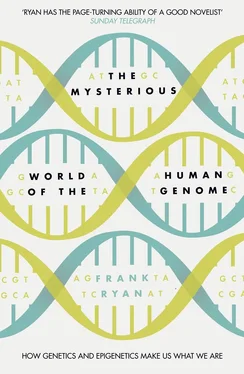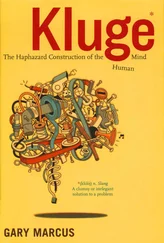When Griffith injected non-virulent R-type pneumococci from the strain known as type I into experimental mice, he included an additional ingredient in the injections, a so-called ‘adjuvant’, which usually pepped up the immune response to the R pneumococci. A common adjuvant for these purposes was mucus taken from the lining of the experimental animal stomach. But for some obscure reason Griffith switched adjuvant to a suspension of S pneumococci, derived from type II, that had been deliberately killed off by heat. The experimental mice died from overwhelming infection. In the blood of these dead mice Griffith expected to find large numbers of multiplying R-type I bacteria – the type that he had injected at the start of the experiment. Why then had he actually found S-type II? How on earth could adding dead bacteria to his inoculum have changed the actual serotype of the bacterium from non-virulent R-type I to highly virulent S-type II?
Researchers, including Avery himself, had previously shown that S and R types were determined by differences in the polysaccharide capsules coating the cell bodies of the bugs. Griffith’s findings suggested that the test bacteria, initially R-type pneumococci, had changed their polysaccharide coats inside the infected bodies of the mice to that of the virulent strain. But they could not have achieved this by just flinging off the old coat and putting on the new one. The coat was determined by the bacteria’s heredity – it was an inherited characteristic. Further cultures of the recovered bacteria confirmed that the S type bred true. There appeared to be only one possible explanation: adding the dead S bacteria to the living R bacteria had induced a mutation in the heredity of the living R-type bacteria, so they literally transformed into S-type II.
In the words of Dubos: ‘[At the time] Griffith took it for granted that the changes remained within the limits of the species. He probably had not envisaged that one pneumococcus type could be transformed into another, as this was then regarded as the equivalent of transforming one species into another – a phenomenon never previously observed.’
*
It is little wonder that Avery was astonished by Griffith’s findings. Like Robert Koch before him, Avery subscribed to the view that bacterial strains were immutable in terms of their heredity. The very concept of a mutation – that heredity was capable of an experimentally induced change – was a highly controversial issue within biology and medicine at this time. To understand why, we need to grasp the concept of what a mutation means.
By the late nineteenth century Darwinian theory had entered a crisis. Darwin himself had been well aware that natural selection relied on some additional mechanism, or mechanisms, capable of changing heredity, so that natural selection would have a range of ‘hereditable variation’ to choose between. Generations later, in the opening chapters of his innovative book Evolution: The Modern Synthesis , Julian Huxley put his finger on the nub of the problem. ‘The really important criticisms have fallen upon Natural Selection as an evolutionary principle and centred round the nature of inheritable variation.’ In 1900, a Dutch biologist, Hugo de Vries, put forward a novel mechanism that would be capable of providing the necessary variation: the concept of a random change in a unit of inheritance. Opportunity for change exists when genes are copied during reproduction, when a random change in the coding of a gene might arise from an error in copying the hereditary information. De Vries called this source of hereditary change a ‘mutation’. It was only with what Julian Huxley termed ‘the synthesis’ of Mendelian genetics – the potential for change in the inherited genes through mutation – and Darwinian natural selection operating on the hereditary choices presented within a species, that Darwinian theory became credible again to the great majority of scientists.
In time Griffith’s finding would be confirmed to be what Avery was now wondering about: it was a mutation. Geneticists would show that the change from the R to the S strain of pneumococcus involved the transfer of a gene from the dead S-type II bacteria to the living R-type I bacteria, which was incorporated into subsequent bacterial reproductive cycles, transforming the cells of the R-type I bacterium into the cells of the S-type II bacterium. It was indeed the bacterial equivalent of a change of species. And Griffith was proven right in inferring that Darwinian natural selection had operated even in the short time frame of the infection of a cohort of laboratory mice.
Griffith’s experimental findings galvanised bacteriologists and immunologists around the world. His discovery was confirmed in several different research centres, including the Robert Koch Institute in Berlin, where the pneumococcal types had first been classified. The news was inevitably a hot topic of discussion in Avery’s department, as Dubos would recount: ‘but we did not even try to repeat them at first, as if we had been stunned and almost paralysed intellectually by the shocking nature of the findings’.
At first Avery simply couldn’t believe that bacterial types could be transformed. Indeed, he had been one of the authoritative figures who had settled the fixity of bacterial reproduction being true to type years before. But from 1926 Avery encouraged a young Canadian physician working in the Rockefeller Laboratory, M. H. Dawson, to investigate the situation. According to Dubos, Dawson, unlike Avery, was convinced from the start that Griffith’s conclusion must be correct because he believed that ‘work done in the British Ministry of Health had to be right’.
Dawson began by confirming Griffith’s findings in laboratory mice. His results suggested that the majority of non-virulent bacteria – the R types – had the ability in certain circumstances to revert to the virulent S type. By 1930 the young Canadian was joined by a Chinese colleague, Richard P. Sia, and between them they took the experimental observations further by confirming that the hereditary transformation could be brought about in culture media, without the need for passage through mice. At this stage, Dawson left the department and Avery encouraged another young physician, J. L. Alloway, to take the investigation further. Alloway discovered that all he needed to bring about the transformation was a soluble fraction derived from the S pneumococci by dissolving the living cells in sodium deoxycholate, then passing the resultant solution through filters to remove the bits of broken-up cells. When he added alcohol to the filtered solution, the active material precipitated out as sticky syrup. Throughout the laboratory this sticky syrup was referred to as the ‘transforming principle’. So the work continued, experiment following experiment, year by year.
When Alloway left the department, in 1932, Avery began to devote some of his own time to the pneumococcus transformation, in particular aiming to improve the extraction and preparation of the transforming substance. Frustration followed frustration. He focused on its chemical nature. Discussion took place with other members of the department, ranging from the ‘plamagene’ that was thought to induce cancer in chickens (now known to be a retrovirus), or to the genetic alterations in bacteria that were thought to be caused by viruses. According to Dubos, Alloway suggested the transforming agent might be a protein-polysaccharide complex. But by 1935 Avery was beginning to think along other lines. In his annual departmental report that year he indicated that he had obtained the transforming material in a form that was essentially clear of any capsular polysaccharide. In 1936, Rollin Hotchkiss, a biochemist who had now arrived to work in the department, wrote a historic comment in his personal notes:
Читать дальше












